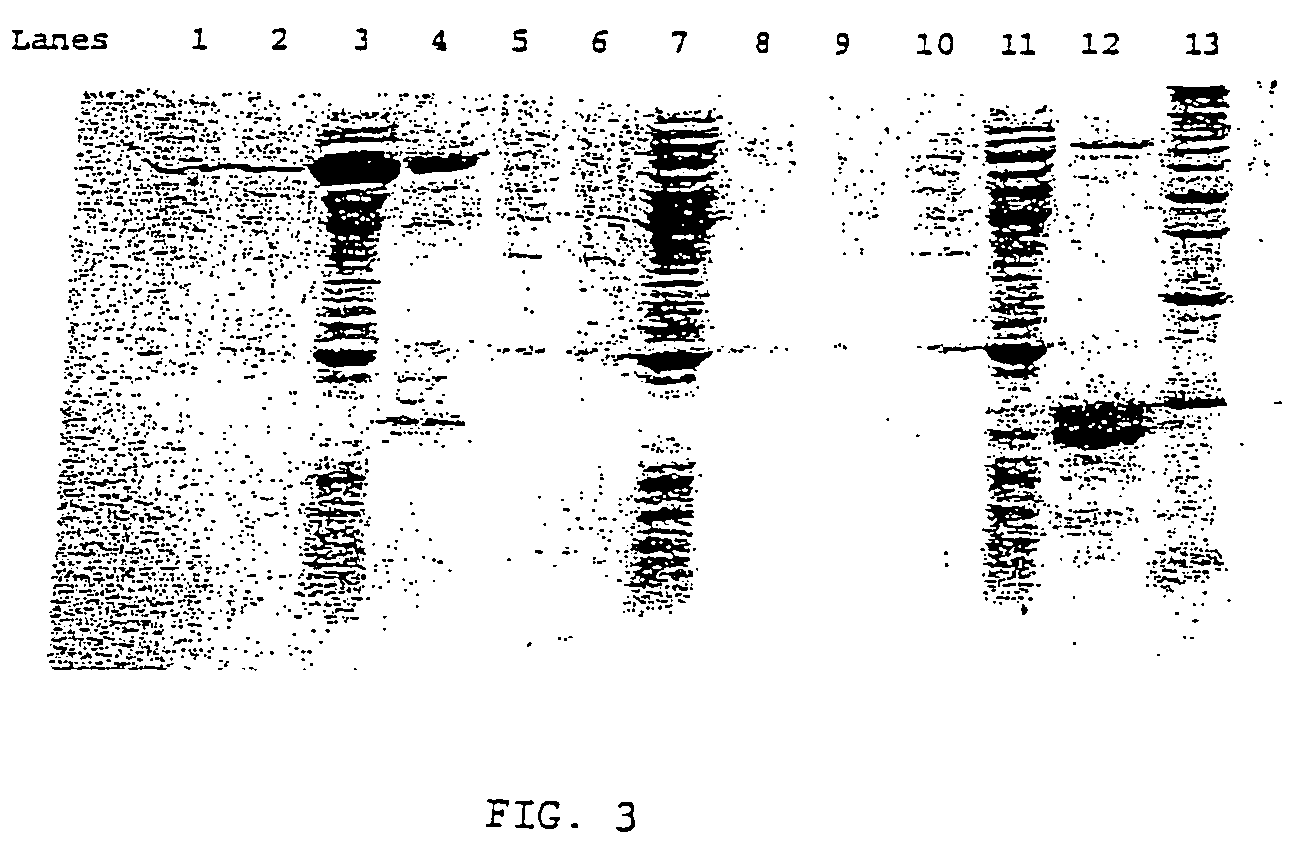Rapidly cleavable SUMO fusion protein expression system for difficult to express proteins
a fusion protein and protein technology, applied in the field of recombinant fusion proteins, can solve the problem of difficult to efficiently express many foreign proteins in active form at high levels
- Summary
- Abstract
- Description
- Claims
- Application Information
AI Technical Summary
Benefits of technology
Problems solved by technology
Method used
Image
Examples
example 1
Expression, Cleavage and HPLC Purification of a 14 mer Peptide Derived from the Sequence for Human IκBα
[0081]The coding region for the IκBα peptide was designed by engineering complementary PCR oligonucleotides that code for an N-terminal BamHI site, the 14 amino acids contained in the coding region for IκBα, and a stop codon followed by a HindIII restriction enzyme site. The complementary primers were annealed, digested with respective restriction enzymes, gel purified, and ligated into a vector containing a hexahistidine tagged Smt3 coding region. An expression strain of E. coli was transformed with the resulting plasmid, grown, and the culture was induced for protein expression. The Smt3-IκBα recombinant fusion protein was isolated from the bacterial lysate by Ni-affinity chromatography and sized by gel filtration. The resulting peak was cleaved using a 1:1000 by mass ratio of Ulp1 to Smt3 fusion. After 2 hours, the mixture was purified by C18 reverse phase HPLC (FIG. 1B), and pe...
example 2
Expression, Purification of the Membrane-Associated Phosphatidylserine Synthase (PSS) Enzymes
[0082]Genes were cloned from E. coli and S. cerevisiae, expressed and purified in E. coli (FIG. 3). The C-terminal histidine tagged E. coli phosphatidylserine synthase (PSS) construct was not sufficiently expressed to allow visualization on Coomassie blue stained SDS gels or in amounts sufficient for purification by Ni-column affinity chromatography. Without being bound by any particular theory, the inventor believes that membrane proteins are generally very difficult to express and purify from bacterial expression systems. By contrast the fusion with the expression enhancing amino acid sequence of the recombinant fusion proteins of the present invention increases both expression and solubility of the recombinant protein. This is shown for example by comparison of the properties of the S. cerevisiae PSS enzyme, and the S. cerevisiae PSS enzyme of the fusion protein. The N-terminal Smt3 tag t...
example 3
Expression, Purification, and Cleavage of Protease-Sensitive mRNA Capping Proteins with the Smt3 Fusion System
[0083]This example demonstrates the protease specificity exhibited by the Ulp1 protease by showing that no degradation of the protease-sensitive mRNA capping proteins was detected. The mRNA capping enzymes from S. cerevisiae (FIG. 4) and C. albicans (FIG. 5) are very sensitive to proteolytic degradation if exposed to thrombin, factor Xa, or PRECISSION™ protease (Pharmacia, Kalamazoo, MI). Several capping enzyme constructs were prepared using the Smt3 fusion system to obtain material with precise cleavage sites posterior to the Ulp1 cleavage sequence. Enzymes were purified using Ni-affinity chromatography. Cleavage of the Smt3-fusions was achieved in a 1-2 hour reaction containing a 1:1000 by mass ratio of protease to fusion protein as described above.
PUM
| Property | Measurement | Unit |
|---|---|---|
| pH | aaaaa | aaaaa |
| weight | aaaaa | aaaaa |
| nucleic acid sequence | aaaaa | aaaaa |
Abstract
Description
Claims
Application Information
 Login to View More
Login to View More - R&D
- Intellectual Property
- Life Sciences
- Materials
- Tech Scout
- Unparalleled Data Quality
- Higher Quality Content
- 60% Fewer Hallucinations
Browse by: Latest US Patents, China's latest patents, Technical Efficacy Thesaurus, Application Domain, Technology Topic, Popular Technical Reports.
© 2025 PatSnap. All rights reserved.Legal|Privacy policy|Modern Slavery Act Transparency Statement|Sitemap|About US| Contact US: help@patsnap.com



